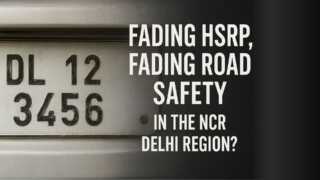The National Capital Region (NCR), known for its relentless traffic and rising vehicle population, has long struggled with the twin challenges of road safety and law enforcement. Among the measures implemented to address these issues was the introduction of High Security Registration Plates (HSRPs), designed to bring uniformity, prevent tampering, and aid authorities in vehicle identification. But today, a new concern is surfacing—the fading of HSRPs themselves.
The Promise of HSRPs
HSRPs were mandated across India to curb vehicle thefts, improve traceability through unique laser-etched numbers, and ensure compatibility with Automatic Number Plate Recognition (ANPR) cameras used by enforcement agencies. The reflective film and embossed alphanumeric fonts were intended to enhance night visibility, thereby improving safety and compliance monitoring.
In theory, HSRPs are the silent guardians of road order—always visible, tamper-proof, and easy to scan.
The Fading Reality in NCR
Yet, on the streets of Delhi and its adjoining NCR cities—Gurugram, Noida, Ghaziabad, and Faridabad—drivers and commuters are reporting a worrying trend. Within just a few years of installation, the HSRP numbers are fading, peeling, or losing reflectivity.
• Visibility drops: Once the ink fades, ANPR cameras struggle to register the plates, defeating their very purpose.
• Enforcement loopholes: Traffic police cannot identify vehicles with clarity, particularly at night or from a distance.
• Safety risk: Emergency responses, such as tracking down hit-and-run vehicles, become significantly harder.
• Owner’s burden: Vehicle owners, who paid for supposedly long-lasting plates, are left with fading and illegible tags, unsure if replacements will be at their cost.
Why Are HSRPs Fading?
Industry insiders and users cite several possible reasons:
• Inferior quality control by some authorized vendors.
• Harsh weather exposure—Delhi’s scorching summers, pollution, and dust accelerate wear.
• Manufacturing defects in the reflective sheeting and embossing process.
• Lack of monitoring from authorities after the initial implementation push.
Implications for Road Safety
The fading HSRP problem is not cosmetic—it’s a systemic risk. If cameras fail to recognize plates, NCR’s investments in AI-based enforcement systems, red-light cameras, speed detectors, and tolling systems lose effectiveness. This compromises the very foundation of road safety and law enforcement technology.
In a city where over 1.2 crore vehicles ply, any dilution in traceability has cascading effects on crime detection, traffic compliance, and citizen safety.
The Way Forward
If left unchecked, fading HSRPs could undo years of progress in vehicle identification and road monitoring. To restore confidence, authorities must act swiftly:
1. Quality Audits – Conduct independent quality checks on HSRPs issued in NCR to identify batches prone to fading.
2. Vendor Accountability – Penalize suppliers providing substandard plates and enforce stricter manufacturing standards.
3. Replacement Policy – Offer free or subsidized replacement of faded HSRPs to vehicle owners, given that these were mandated purchases.
4. Periodic Inspections – Make HSRP visibility checks part of pollution control or fitness certification regimes.
5. Technology Integration – Explore digital augmentation, such as RFID-based validation, to supplement visual number plate recognition.
Conclusion
HSRPs were meant to strengthen road safety and law enforcement in Delhi-NCR. But as they fade prematurely, so too does the promise of safer, smarter roads. Without urgent corrective measures, what was introduced as a shield against chaos may instead become a symbol of half-baked implementation.
After all, a plate that cannot be read is a plate that cannot protect.
Source: worldautoforum.com






